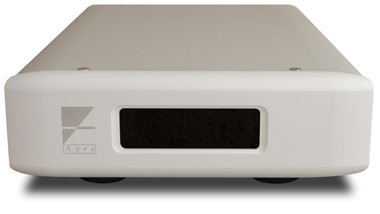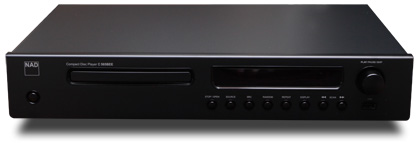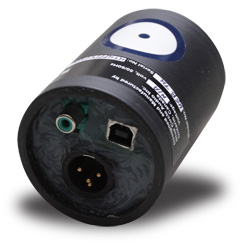 February 2010
Tools of the Computer Trade: Part Two
In last month’s editorial, I
talked about why I feel that the future of audiophile-based music systems will involve not
a physical disc format like CD or SACD, but music files stored on computers and played
using high-quality digital-to-analog converters (DACs). If you’ve been following
what’s been going on in audio the last few years, this is hardly an earth-shattering
prediction. Sales of CDs have been on the wane for a decade; the newer digital formats of
SACD and DVD-Audio never grabbed market share; and for years now, many people have been
assembling systems just like the one I’ve described, not only to improve the quality
and convenience of CD-resolution playback, but to take advantage of the higher-rez formats
available today. The question most relevant to readers now is, If I don’t already
have this kind of system, how do I create one?
This article describes my own foray into computer-based
digital audio. I’ll tell you what I’m currently using here in my reference room,
including the pros and cons of such a system. It might give you some idea of how to build
your own such system, now or in the future.
Although there are other companies out there, digital
photography is ruled by Canon and Nikon. They’re biggies, and their products are what
most consumers shop for. Unfortunately, their systems aren’t compatible; when you get
into digital photography, you go with one brand or the other. Each has its pros and cons,
its admirers and detractors.
Computers are pretty much the same. You have Apple Macs,
and then you have all the Windows-based PCs. Our editor-in-chief, Jeff Fritz, has gone the
Apple route, using a MacBook laptop. I’m on the other side of the fence, with a Sony
Vaio laptop running Windows Vista. As with digital cameras, you’ll hear arguments
from both sides for which computer system is better. But such disputes can’t really
be resolved; each system has its pros and its cons. You just pick one and stick with it.
Many people have reported problems with Vista, but
I’ve never had one. On the other hand, I wish that the soundcard built into my
laptop, which is now just over three years old, supported resolutions higher than
24-bit/96kHz. I don’t want to replace this computer just now, but if I were buying a
new laptop today, I’d make sure its card supported 24/192, to take me a little bit
further into the future -- music is now available in that resolution, and more will be
coming our way.
Besides the operating system and soundcard, you need a
software-based music player. There are a number of Windows-compatible players, but I
settled on foobar2000, which is available online for free and permits bit-perfect
transfers of high-resolution material when you add on what’s called "kernel
streaming." Then you’ll need something to play. Sometimes I download files;
other times I rip CDs using Exact Audio Copy -- which, like foobar2000, is free.
Before I mention the other components in my system, I have
to clarify one thing: I could use the DAC on my computer’s internal soundcard
and just connect the analog outputs to my preamplifier’s inputs. But the sound
quality of this cheap card doesn’t satisfy me, and I haven’t come across one
that has. That’s why I feel I need a high-quality external DAC.
 There are a number of ways to get the
digital signal out of your computer and into a DAC: two of the more popular connections
are FireWire and USB. FireWire is a good connection and is common on Apple Macs and Sony
PCs (mine has it). I suspect that’s not for its audio but its video capabilities,
which Apple and Sony are both big into. Some DACs support that interface, notably Weiss,
but USB is the standard to which most audio companies now design their DACs. There are a number of ways to get the
digital signal out of your computer and into a DAC: two of the more popular connections
are FireWire and USB. FireWire is a good connection and is common on Apple Macs and Sony
PCs (mine has it). I suspect that’s not for its audio but its video capabilities,
which Apple and Sony are both big into. Some DACs support that interface, notably Weiss,
but USB is the standard to which most audio companies now design their DACs.
One of the very best USB-type DACs now on the market is the
QB-9, from Ayre Acoustics of Boulder, Colorado. It’s designed from the ground up to
be the best USB DAC Ayre could build for a reasonable price ($2500 USD). They’ve
succeeded. The QB-9 works flawlessly and sounds fantastic, supporting resolutions up to
24/96, and is upgradeable to play 24/192 when that becomes available. If you want to know all
the details -- there are plenty -- read Peter Roth’s excellent review
of the QB-9 on our sister site, Ultra Audio.
If you’re committed to high-end computer-based audio right
now, the QB-9 is the DAC to get for its ability to deliver very high performance at a
price that, for an audiophile-grade component, is still reasonable. But before you get out
your credit card, know that one of the QB-9’s great strengths is also its only
limitation. The QB-9 is equipped with a USB input that, to minimize jitter, operates
asynchronously. The weakness is that this USB input is the only digital input the
QB-9 has -- you can’t attach the QB-9 to a CD transport that has a traditional S/PDIF
digital output. To play CDs through the QB-9, you’ll have to first rip them to your
computer, or play the discs using the computer’s built-in drive.
But spend some time with the QB-9 hooked up to your
computer and it won’t take you long to discover why computer-based digital audio is
growing. I downloaded Ola Gjeilo’s Stone Rose (2L 2L48SACD), which I wrote about last December, as a series of 24/96
FLAC files. (The album was originally recorded at 24/96, so these downloads have allowed
me to hear the recording at its "native" sampling rate -- no insignificant
thing.) I compared the sound of that download to the CD edition, using the best CD player
I have on hand: Simaudio’s Moon Evolution SuperNova. The SuperNova sounded great, as
always, but the higher-resolution FLAC files through the QB-9 sounded better yet -- a
fuller re-creation of space, more presence to the piano, and better decay from
Gjeilo’s keystrokes. Plain ol’ CD, no matter how good the player, sounded dated
by comparison.
 But not everyone has $2500 to spend
on a DAC that accepts only USB. If you still want to spin CDs easily and would rather get
your feet wet with something very inexpensive that still sounds good, there’s a fine
option for you: NAD’s C 565BEE CD player ($799), which has a TosLink digital
input that’s claimed to handle PCM datastreams up to 24/192. I reviewed the
NAD C 565BEE last December, and was so smitten with it as a CD player that I
bought the review sample and promised myself that I’d experiment with it as a hi-rez
DAC. Now I have. But not everyone has $2500 to spend
on a DAC that accepts only USB. If you still want to spin CDs easily and would rather get
your feet wet with something very inexpensive that still sounds good, there’s a fine
option for you: NAD’s C 565BEE CD player ($799), which has a TosLink digital
input that’s claimed to handle PCM datastreams up to 24/192. I reviewed the
NAD C 565BEE last December, and was so smitten with it as a CD player that I
bought the review sample and promised myself that I’d experiment with it as a hi-rez
DAC. Now I have.
Because the C 565BEE doesn’t have a hi-rez USB
input (its front-mounted USB jack supports only MP3 and WMA files, which are both lower
than CD resolution), you’ll need a device to convert USB to TosLink -- which is
exactly what Blue Circle Audio’s new USB Tunnel 24/96 was created for. The USB Tunnel
24/96 (from $399, depending on configuration) will convert a USB signal from your computer
into RCA- or BNC-based S/PDIF, XLR-based AES/EBU, or what the C 565BEE needs:
TosLink. And, true to its name, the USB Tunnel 24/96 will pass datastreams up to
24-bit/96kHz.
 The USB Tunnel 24/96 is an ugly
little thing, but it’s simple to set up and proved flawless in use. Since the Blue
Circle is powered straight from a USB port, the only wires are the USB cable that links it
to the computer, and the TosLink cable from the Blue Circle to my NAD C 565BEE. Once
connected, my computer recognized the Blue Circle as a valid USB device, the NAD locked to
it, and in no time flat music came through -- beautifully. I compared the Stone
Rose CD (played in the NAD) to the 24/96 FLAC download and heard the same striking
improvements I’d heard when I compared the QB-9 to the Simaudio SuperNova: superior
space, decay, and presence. In fact, I liked the sound of these hi-rez files played
through the USB Tunnel 24/96 and C 565BEE better than the CD through the
SuperNova, which costs over $6000. That’s the way it is when you have
higher-resolution source material, I guess -- as the resolution increases, you can have
better sound for a fraction of the price. The USB Tunnel 24/96 is an ugly
little thing, but it’s simple to set up and proved flawless in use. Since the Blue
Circle is powered straight from a USB port, the only wires are the USB cable that links it
to the computer, and the TosLink cable from the Blue Circle to my NAD C 565BEE. Once
connected, my computer recognized the Blue Circle as a valid USB device, the NAD locked to
it, and in no time flat music came through -- beautifully. I compared the Stone
Rose CD (played in the NAD) to the 24/96 FLAC download and heard the same striking
improvements I’d heard when I compared the QB-9 to the Simaudio SuperNova: superior
space, decay, and presence. In fact, I liked the sound of these hi-rez files played
through the USB Tunnel 24/96 and C 565BEE better than the CD through the
SuperNova, which costs over $6000. That’s the way it is when you have
higher-resolution source material, I guess -- as the resolution increases, you can have
better sound for a fraction of the price.
The Blue Circle USB Tunnel 24/96 with NAD C 565BEE did
fall short of the Ayre QB-9 by a little bit. The QB-9’s extraordinary resolution is
perfectly complemented by a nonfatiguing sound that I can listen to forever. The combo of
Blue Circle and NAD approached but didn’t beat it, so there’s still reason to
pay more. But even though the Blue Circle and NAD didn’t match the QB-9 straight from
my computer, it did get close, and for less than half the price -- which to me,
given its quality and versatility, makes the combo a no-brainer purchase. (Remember, the C
565BEE plays CDs, too.) What’s more, the NAD is equipped for 24/192 input. When I can
send that resolution from my computer, I’ll be interested to hear the results.
Stay tuned . . .
I’m an audio reviewer, and thus privy to the best
equipment there is, but what I use in my own system can be had for a very reasonable
price. After all, most readers are less interested in pie-in-the-sky stuff than in
equipment they can actually afford. Whether you use a USB DAC like the Ayre QB-9, a
combination like the Blue Circle Audio USB Tunnel 24/96 and NAD C 565BEE, or
something else, getting into computer-based audio should be a priority if you want to
sample the future of digital playback right now. It’s certainly changed the way I
listen to my system, and there’s a good chance it can change yours as well.
. . . Doug Schneider
das@soundstage.com
|

